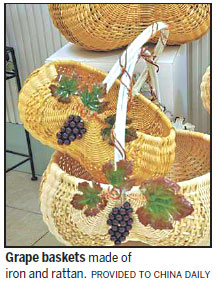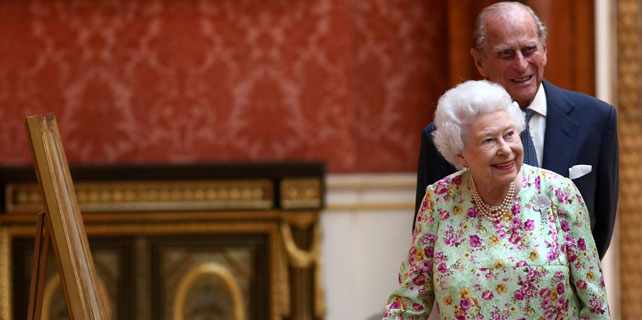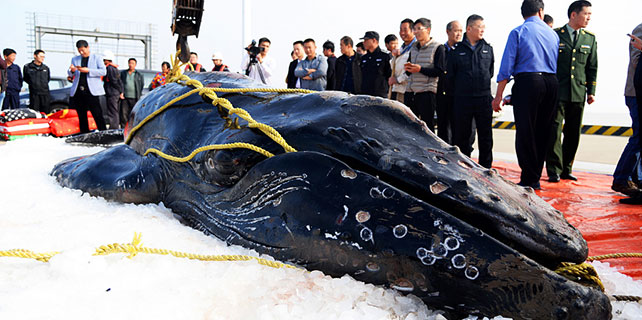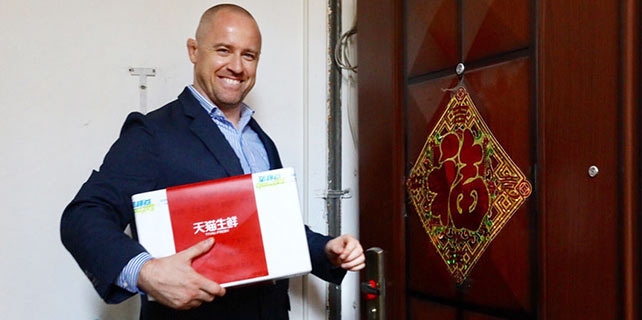Adding a personal touch to tradition
"In Chinese, wenhua means culture. The word is made up of two characters. Wen stands for history and hua refers to the process of change," says Guo Aihe, a 53-year old ceramist and curator of the Luoyang Sancai Art Museum. "Our generation has to make some changes to promote the development of culture."
Guo was an exhibitor in the 2017 World Leisure Expo in Hangzhou, Zhejiang province, in late October, introducing his artworks to visitors from around the world.
He has devoted his time to the inheritance and development of sancai art for more than 30 years, focusing on glaze paintings, ceramic crafts and other archaic forms of sancai.
His artworks have been added to the permanent collections of the Louvre in France, the Corfu Museum of Asian Art in Greece, the Gwangju Museum of Art in South Korea and many national institutions.
|
Large-scale mural Guo Zhi Zhong, Cheng Zhi Yuan (The Center of the Country, The Origin of the Cities) by Guo Aihe, exhibited at the Henan pavilion at 2010 Shanghai World Expo. Photos Provided to China Daily |
|
From left: Yu Le Tu (Fishes and Happiness) displayed in Shanghai Tower; sancai glaze painting Sunflower by Guo Aihe; Guo paints on pottery. |
|
Sancai glaze painting Terraced Fields by Guo Aihe. |
He was born in Luoyang, Henan province, in 1964 and graduated from Luoyang Normal University after studying art.
"Sancai pieces in the shape of horses and camels are everywhere," he says. "Sancai has been the top choice for presents. Around 35 years ago, a quality sancai camel sold for 38 yuan ($5.75; 4.85 euros; £4.25), the equivalent of about one month's salary."
Since Guo grew up in the place where sancai originated, it is no coincidence that he was drawn to it.
He is proud to share his knowledge of sancai through his lectures and books, including China Luoyang Sancai.
According to Guo, the word "porcelain" was invented to represent enameled pottery. Sancai is the most famous representation of porcelain.
"Sancai used to be misunderstood as meaning 'three-colored' in the West because of its direct translation. But actually it means the whole spectrum of colors that occur in the world."

Guo says Tang sancai only represents one development phase of porcelain, the history of which can be traced back to the Western Zhou Dynasty (c. 11th century-771 BC).
"Dating back for more than 1,000 years, sancai art employed the most cutting-edge techniques of the day in the fields of mineralogy, physics, kiln technology, design and the engraving arts."
Guo values traditional crafts for producing genuine art treasures, and is eager to innovate and add modern advances to its development.
"Our country needs people who inherit just as much as it needs those who innovate," he says. "I want sancai works of my own creation to be displayed in museums 100 years from now, and not just some copies of Tang sancai I once produced."
He believes that innovation that ignores the art form's history and singularity in favor of a purely Western interpretation will not have any lasting value��like a tree without roots.
Guo applies modern artistic expression to porcelain production, based on traditional craft.
During his university studies, he learned about traditional Chinese painting, oil painting and watercolors, which he says are elements reflected in his sancai works.
He has been bold enough to try 500 new types of bright and semitransparent colors in glazes, while traditional sancai always remains loyal to white, yellow and green. He has departed from the tradition that ties the ceramist to the three-dimensional figures, including horses and camels, and has expanded the subjects of his creations using sancai glaze painting techniques.
One of Guo's works that is worth mentioning, titled Guo Zhi Zhong, Cheng Zhi Yuan (The Center of the Country, The Origin of the Cities), graced the Henan pavilion at the 2010 Shanghai World Expo. It won the gold "Bai Hua" Grand Award for Chinese Arts and Crafts issued by the Chinese Arts and Crafts Association in Beijing.
The work is a large-scale mural, 25.8 meters long and 3.3 meters high. It was created using 2,516 pieces of artwork, including 2,359 ceramic tiles decorated with sancai to create the background, six bronzes that form the title in the style of a seal and one piece of Dushan jade from Nanyang that had been carved into the character Yu, an abbreviation for Henan province.
The work, as suggested by its title, has two themes.

The pattern from an ancient bronze tripodal urn unearthed in Henan province has been pieced together to form the center of the work. Twenty-six dynasties in ancient China once had their capitals in today's Henan, and their names are painted in the style of oracles around the central character for Yu, reinforcing the message that Henan lies at the center of China.
To reflect the origin of cities as another theme, the Yellow River runs through historic sites in the background, including Yangshao, the Yin Ruins in Anyang, the ancient capital of Erlitou and the ancient cities of the Eastern Han (25-220) and Wei (220-265) dynasties. Patterns from ancient Chinese stories, called hetu and luoshu, have been revived as a reminder of the Yellow River's ancient mythology.
Another famous piece named Yu Le Tu (Fishes and Happiness) is displayed in the hall of Shanghai Tower. Completed in 2015, the tower is 632 meters high and was the tallest building in the world at that time.
The work was completed by Guo and 17 other artists.
It gathered wisdom from all over the country, including sancai works from Luoyang, blue-and-white porcelain from Jingdezhen in Jiangxi province, Jun and Ru porcelain from Yuzhou and Ruzhou in Henan province, and works from the Ding kiln in Quyang, Hebei province, the Ge kiln in Longquan, Zhejiang province, and purple sand clay works from Yixing, Jiangsu province.
This piece of art was tailor-made for the tower and was scrupulously designed with attention to detail. The 2,015 glazed ceramic boards echo the year the artwork was created, the 127 columns of the work reflect the number of floors in the building, and the 632 flying fish mirror the height of the tower.
Guo has also made a foray into watch design, using Luoyang sancai to make watch dials. Due to variables in the kiln-firing process and the nature of glaze, each dial is unique and impossible to re-create.
The 12 signs of the Chinese zodiac replace the Roman and Arabic numerals more commonly used to tell the time.
The design of the dial created by Guo is imbued with traditional culture and has attracted a great deal of attention.
Guo says that at an international watch exhibition in Switzerland last year, a local resident bought a watch and mailed it back to China with a request it be signed by the artist.
"The buyer said that he bought it as a gift for his wife, the woman he loves and cherishes the most. He said it would be perfect with my signature on it."
Guo is proud that one of his designs has been recognized by the West.
Even after producing so many artworks and establishing a museum, Guo has a bigger dream.
He had been looking for a large space to create a sancai ceramic town, and in 2015 locked onto a small village named Huashu'ao in a mountainous area of western Henan.
In the town, he displays his innovative pieces as well as copies of sancai from different eras. He is developing the town as a window for people to learn about the history of the art form and its modern interpretations, which will help them to appreciate the beauty of sancai from all aspects.
"The town is 200 hectares in size. It is a large work of art in itself, as sancai art has been blended into the construction of the space," Guo says.
Root carving
Liu Xiaoping also participated in the 2017 World Leisure Expo. The 47-year-old artist from Lishui, Zhejiang province, has been practicing root carving for almost 30 years.
He says that he always follows the principle of applying 30 percent human creativity while maintaining 70 percent of the nature of the raw material in his works.
He invented flat carving, a process that shapes thin, hollow or flat roots by compressing them from all angles.
Dao Fa Zi Ran (Tao Follows Nature), Liu's magnum opus using the flat carving technique, is 80 centimeters high and 35 cm wide��but no more than 4 cm thick.
In this work, Liu has perfectly taken advantage of the uneven depth of the material and skillfully structured the artwork to form a vivid facial expression combined with a figurelike posture.
Liu says: "As there aren't many quality raw materials, flat carving explores the possibility of flat roots, which haven't been valued for what they are. By shaping them into an artwork, an artist can improve their ability in utilizing materials and sculpting."
At the expo, Liu also displayed a series of works named Ren Jian Wan Xiang (The Various Aspects of Life).
Liu says he cherishes each piece of wood as a gift from nature that should never be wasted, including the ones with holes in them.
He is charmed by the beauty of imperfection and thinks every hole says something about the secrets of time.
Using wood with naturally occurring holes as the mouths of figures, he endeavors to express a range of human emotions, from sorrow to anger and happiness.
"Cavities are very connotative. They offer fewer limitations than carving a mouth on purpose", Liu says, accepting that this technique will bring different interpretations to his works. "The audiences will see what's inside them."
Liu claims that all his works reflect his thinking, even including the most traditional ones of Maitreya, or the Laughing Buddha.
He spends time investigating what's on the market, what has already been done and to what standard it has been produced. Then he thinks about what he should do next.
"My understanding of a craftsman's spirit is different from most of the others," Liu says. "Only after observation and summarization do I know what I should do to make a difference and create something new."
Rattan weaving
Another exhibitor at the expo, Chen Qinghe, 78, comes from Anxi county in Fujian province. He is also a master of a Chinese craft that pays attention to a material that is normally underestimated.
In 1958, Chen started to study rattan weaving for the sake of a 2-yuan ($1 at the exchange rate of those days) grant as the only student of the subject at the Xiamen Academy of Arts and Design.
He says the 2 yuan covered half his monthly living expenses at that time, "I stayed just because of the grant, and I thought the craft would support me in making a living."
After his graduation, he started to produce rattan-weaved Thermos flask cases to sell. He later established a studio where he has since been passing down his skills to others.
Chen says he was anxious to prevent the traditional craft from dying out when he found younger generations showing no interest, especially those from the post-'90s generation.
To achieve this, in 1991 he created a brand-new craft that combines rattan with ironwork.
He has designed a series of baskets that use steel reinforcement bars as handles, with iron wire twined around it to form a grapevine design. Iron sheets are cut into the shape of grape leaves and steel balls are soldered together to form clusters of grapes.
At one spring trade fair, the baskets attracted frenzied buying among overseas customers. Within three days, Chen took in enough advance orders to support a year's production.
"Innovation is the soul and the lifeblood of the domestic cultural crafts industry," Chen says. He believes that good design promotes trade.
Chen says the rattan weaving combined with ironwork has opened up a broader market for his home county. "In Anxi county, with a population of 1.2 million, we now have 120,000 people working in basket-making and its related industries," he says. "The total output value over the past seven years has reached 10.8 billion yuan."
In June, Chen successfully combined Chinese lacquer art with rattan weaving.
"Lacquer art is a national intangible cultural heritage, and so is rattan weaving," he says, speaking of his creations with pride. "The production process is not easy and needs more than 10 steps."
Chen says, "What we have to pass on is the craftsman's spirit of making perfection even more perfect."
xuhaoyu@chinadaily.com.cn
(China Daily Africa Weekly 12/08/2017 page1)



















